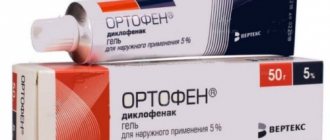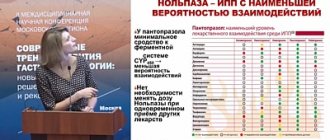Aspicor enteric-coated tablets 100 mg N90
Registration Certificate Holder
VERTEX (Russia)
Dosage form
Medicine - Aspicor® (Aspikor)
Description
Enteric-coated tablets
white or almost white, round, biconvex; on a cross section - a homogeneous mass of white or almost white color.
1 tab.
acetylsalicylic acid 100 mg
Excipients
: microcrystalline cellulose, lactose monohydrate, croscarmellose sodium, colloidal silicon dioxide (aerosil), stearic acid.
Composition of the enteric coating:
copolymer of methacrylic acid and ethyl acrylate, propipylene glycol, macrogol 4000, titanium dioxide, talc.
10 pieces. — cellular contour packages (1) — cardboard packs. 10 pieces. — contour cell packaging (2) — cardboard packs. 10 pieces. — cellular contour packages (3) — cardboard packs. 10 pieces. — contour cell packaging (6) — cardboard packs. 20 pcs. — cellular contour packages (1) — cardboard packs.
Indications
- prevention of acute myocardial infarction in the presence of risk factors (for example, diabetes mellitus, hyperlipidemia, hypertension, obesity, smoking, old age);
- prevention of recurrent myocardial infarction;
- unstable angina;
- prevention of stroke (including in patients with transient cerebrovascular accident);
- prevention of transient cerebrovascular accident;
- prevention of thromboembolism after surgery and invasive vascular interventions (for example, coronary artery bypass grafting, carotid endarterectomy, arteriovenous bypass, carotid angioplasty);
- prevention of deep vein thrombosis and thromboembolism of the pulmonary artery and its branches (for example, with prolonged immobilization as a result of major surgery).
Contraindications for use
- erosive and ulcerative lesions of the gastrointestinal tract;
- gastrointestinal bleeding;
- hemorrhagic diathesis;
- bronchial asthma induced by the intake of salicylates and NSAIDs, the Fernand-Vidal triad (a combination of bronchial asthma, recurrent polyposis of the nose and paranasal sinuses and intolerance to acetylsalicylic acid);
- combined use with methotrexate at a dose of 15 mg per week or more;
- I and III trimesters of pregnancy;
- lactation period (breastfeeding);
- age under 18 years;
- hypersensitivity to the components of the drug;
- hypersensitivity to other NSAIDs.
Carefully _
should be used for gout, hyperuricemia, a history of ulcerative lesions of the gastrointestinal tract or gastrointestinal bleeding, renal and liver failure, bronchial asthma, chronic respiratory diseases, hay fever, nasal polyposis, allergic reactions to other drugs, in the second trimester of pregnancy, in combination with methotrexate at a dose of less than 15 mg per week. with deficiency of vitamin K and glucose-6-phosphate dehydrogenase.
pharmachologic effect
NSAID, antiplatelet agent. The mechanism of action of acetylsalicylic acid is based on irreversible inhibition of cyclooxygenase-1 (COX-1), resulting in blockade of thromboxane A2 synthesis and suppression of platelet aggregation. It is believed that acetylsalicylic acid has other mechanisms of suppressing platelet aggregation, which expands the scope of its use in various vascular diseases.
Acetylsalicylic acid also has anti-inflammatory, analgesic, and antipyretic effects.
Drug interactions
When used simultaneously, acetylsalicylic acid enhances the effect of the following drugs:
- methotrexate by reducing renal clearance and displacing it from protein binding;
- heparin and indirect anticoagulants due to disruption of platelet function and displacement of indirect anticoagulants from binding with proteins;
- thrombolytic and antiplatelet drugs (ticlopidine);
- digoxin due to a decrease in its renal excretion;
- hypoglycemic agents (insulin and sulfonylurea derivatives) due to the hypoglycemic properties of acetylsalicylic acid itself in high doses and displacing sulfonylurea derivatives from binding with proteins;
- valproic acid by displacing it from bonds with proteins.
An additive effect is observed when acetylsalicylic acid is taken simultaneously with ethanol.
Acetylsalicylic acid weakens the effect of uricosuric drugs (benzbromarone) due to competitive tubular elimination of uric acid.
By enhancing the elimination of salicylates, systemic corticosteroids weaken their effect.
Dosage regimen
The tablets should be taken orally, before meals, with plenty of liquid.
Prevention for suspected acute myocardial infarction:
100-200 mg/day (the first tablet must be chewed for faster absorption).
Prevention of new-onset acute myocardial infarction in the presence of risk factors:
100 mg/day.
Prevention of recurrent myocardial infarction, unstable angina, prevention of stroke and transient cerebrovascular accident, prevention of thromboembolic complications after surgery or invasive examinations:
100-300 mg/day.
Prevention of deep vein thrombosis and thromboembolism of the pulmonary artery and its branches:
100-200 mg/day.
The drug is intended for long-term use. The duration of therapy is determined by the attending physician.
Overdose
Symptoms of moderate overdose:
nausea, vomiting, tinnitus, hearing loss, dizziness, confusion.
Treatment:
reducing the dose of the drug.
Symptoms of severe overdose:
fever, hyperventilation, ketoacidosis, respiratory alkalosis, coma, cardiovascular and respiratory failure, severe hypoglycemia.
Treatment:
immediate hospitalization in specialized departments for emergency treatment - gastric lavage, determination of acid-base balance, alkaline and forced alkaline diuresis, hemodialysis, administration of solutions, activated charcoal, symptomatic therapy. When carrying out alkaline diuresis, it is necessary to achieve pH values between 7.5 and 8. Forced alkaline diuresis should be carried out when the concentration of salicylates in plasma is more than 500 mg/l (3.6 mmol/l) in adults and 300 mg/l (2.2 mmol/l) in children.
Side effect
From the digestive system:
nausea, heartburn, vomiting, pain in the abdomen, ulcerative lesions of the mucous membrane of the stomach and duodenum (including perforated ones), gastrointestinal bleeding, increased activity of liver enzymes.
From the respiratory system:
bronchospasm.
From the hematopoietic system
: increased bleeding;
rarely - anemia. From the side of the central nervous system:
dizziness, tinnitus.
Allergic reactions:
urticaria, Quincke's edema, anaphylactic reactions.
special instructions
Acetylsalicylic acid can provoke bronchospasm, as well as cause attacks of bronchial asthma and other hypersensitivity reactions. Risk factors include a history of bronchial asthma, hay fever, nasal polyposis, chronic respiratory diseases, and allergic reactions to other drugs (for example, skin reactions, itching, urticaria).
Acetylsalicylic acid can cause bleeding of varying severity during and after surgery.
The combination of acetylsalicylic acid with anticoagulants, thrombolytics and antiplatelet drugs is accompanied by an increased risk of bleeding.
Acetylsalicylic acid in low doses can provoke the development of gout in predisposed individuals (those with reduced excretion of uric acid).
The combination of acetylsalicylic acid with methotrexate is accompanied by an increased incidence of side effects from the hematopoietic organs.
High doses of acetylsalicylic acid have a hypoglycemic effect, which must be kept in mind when prescribing it to patients with diabetes mellitus receiving hypoglycemic drugs.
When prescribing corticosteroids and salicylates in combination, it should be borne in mind that during treatment the level of salicylates in the blood is reduced, and after discontinuation of corticosteroids, an overdose of salicylates is possible.
The combination of acetylsalicylic acid with ibuprofen is not recommended, since the latter worsens the beneficial effect of Aspicor on life expectancy.
Exceeding the dose of acetylsalicylic acid is associated with the risk of gastrointestinal bleeding.
Overdose is especially dangerous in elderly patients.
When acetylsalicylic acid is combined with alcohol, there is an increased risk of damage to the gastrointestinal mucosa and prolongation of bleeding time.
Effect on the ability to drive vehicles and operate machinery.
There was no observed effect of the drug on the ability to drive vehicles and operate machinery.
Storage conditions
The drug should be stored out of the reach of children, in a dry place, protected from light, at a temperature not exceeding 25°C.
Best before date
Shelf life: 2 years.
Use during pregnancy and breastfeeding
Restrictions during pregnancy - Contraindicated. Restrictions when breastfeeding - Contraindicated.
The use of salicylates in high doses in the first trimester of pregnancy is associated with an increased incidence of fetal defects (cleft palate, heart defects). In the second trimester of pregnancy, salicylates can be prescribed only taking into account a strict assessment of risks and benefits.
In the third trimester of pregnancy, salicylates in high doses (more than 300 mg/day) cause inhibition of labor, premature closure of the ductus arteriosus in the fetus, increased bleeding in the mother and fetus, and administration immediately before birth can cause intracranial hemorrhages, especially in premature infants. The administration of salicylates in the third trimester of pregnancy is contraindicated.
Salicylates and their metabolites are excreted in small quantities into breast milk. Accidental intake of salicylates during lactation is not accompanied by the development of adverse reactions in the child and does not require cessation of breastfeeding. However, if long-term use of the drug is necessary or if it is prescribed in a high dose, breastfeeding should be stopped immediately.
Use for renal impairment
Restrictions for impaired renal function - With caution.
Should be used with caution if there is a history of renal failure.
Use for liver dysfunction
Restrictions for liver dysfunction - With caution.
Use with caution if there is a history of liver failure.
Use in children
Restrictions for children - Contraindicated.
Contraindication: age under 18 years.
Terms of sale
The drug is approved for use as a means of OTC.
Contacts for inquiries
VERTEX JSC (Russia)
199106 St. Petersburg Vasilyevsky Island, 24-liniya, no. 27, lit. A Tel/fax
Aspirin cardio Aspicor tablet p o film 100 mg x90
Registration certificate holder: VERTEX, JSC (Russia)
Manufactured by: VERTEKS, JSC (Russia)
Contacts for inquiries: VERTEX JSC (Russia) ATX code: B01AC06 (Acetylsalicylic acid) Active substance: acetylsalicylic acid Ph.Eur. European Pharmacopoeia
Dosage form
Aspicor®
Tab., cover. enteric coated, 100 mg: 10, 20, 30 or 60 pcs.reg. No.: LS-000440 dated 08/31/10 - Valid
Release form, packaging and composition of Aspicor®
Tablets, enteric-coated, white or almost white, round, biconvex, in cross section - a homogeneous mass of white or almost white.
1 tab.
acetylsalicylic acid 100 mg
Excipients: microcrystalline cellulose, lactose monohydrate, croscarmellose sodium, colloidal silicon dioxide (aerosil), stearic acid.
Composition of the enteric coating: copolymer of methacrylic acid and ethyl acrylate, propylene glycol, macrogol 4000, titanium dioxide, talc.
10 pieces. — cellular contour packages (1) — cardboard packs. 10 pieces. — contour cell packaging (2) — cardboard packs. 10 pieces. — cellular contour packages (3) — cardboard packs. 10 pieces. — contour cell packaging (6) — cardboard packs. 20 pcs. — cellular contour packages (1) — cardboard packs.
Clinical and pharmacological group: NSAIDs. Antiplatelet agent Pharmacotherapeutic group: NSAIDs
pharmachologic effect
NSAID, antiplatelet agent. The mechanism of action of acetylsalicylic acid is based on irreversible inhibition of cyclooxygenase-1 (COX-1), resulting in blockade of thromboxane A2 synthesis and suppression of platelet aggregation. It is believed that acetylsalicylic acid has other mechanisms of suppressing platelet aggregation, which expands the scope of its use in various vascular diseases.
Acetylsalicylic acid also has anti-inflammatory, analgesic, and antipyretic effects.
Pharmacokinetics
Suction
After oral administration, acetylsalicylic acid is absorbed from the upper small intestine. Cmax in blood plasma is observed on average 3 hours after taking the drug orally.
Metabolism
Acetylsalicylic acid undergoes partial metabolism in the liver with the formation of less active metabolites.
Removal
It is excreted by the kidneys, both unchanged and in the form of metabolites. T1/2 of acetylsalicylic acid is about 15 minutes, for metabolites - about 3 hours.
Indications for the drug Aspicor®
prevention of acute myocardial infarction in the presence of risk factors (for example, diabetes mellitus, hyperlipidemia, arterial hypertension, obesity, smoking, old age), prevention of recurrent myocardial infarction, unstable angina, prevention of stroke (including in patients with transient cerebrovascular accident ), prevention of transient cerebrovascular accident, prevention of thromboembolism after surgery and invasive vascular interventions (for example, coronary artery bypass grafting, carotid endarterectomy, arteriovenous bypass, carotid angioplasty), prevention of deep vein thrombosis and thromboembolism of the pulmonary artery and its branches (for example, with prolonged immobilization as a result of major surgery). ICD-10 codes
Dosage regimen
The tablets should be taken orally, before meals, with plenty of liquid.
Prevention for suspected acute myocardial infarction: 100-200 mg/day (the first tablet must be chewed for faster absorption).
Prevention of new-onset acute myocardial infarction in the presence of risk factors: 100 mg/day.
Prevention of recurrent myocardial infarction, unstable angina, prevention of stroke and transient cerebrovascular accident, prevention of thromboembolic complications after surgery or invasive studies: 100-300 mg/day.
Prevention of deep vein thrombosis and thromboembolism of the pulmonary artery and its branches: 100-200 mg/day.
The drug is intended for long-term use. The duration of therapy is determined by the attending physician.
Side effect
From the digestive system: nausea, heartburn, vomiting, pain in the abdomen, ulcerative lesions of the mucous membrane of the stomach and duodenum (including perforated ones), gastrointestinal bleeding, increased activity of liver enzymes.
From the respiratory system: bronchospasm.
From the hematopoietic system: increased bleeding, rarely - anemia.
From the side of the central nervous system: dizziness, tinnitus.
Allergic reactions: urticaria, Quincke's edema, anaphylactic reactions.
Contraindications for use
erosive and ulcerative lesions of the gastrointestinal tract, gastrointestinal bleeding, hemorrhagic diathesis, bronchial asthma induced by the intake of salicylates and NSAIDs, the Fernand-Vidal triad (a combination of bronchial asthma, recurrent nasal polyposis and paranasal sinuses and intolerance to acetylsalicylic acid), combined use with methotrexate in a dose 15 mg per week or more, I and III trimesters of pregnancy, lactation period (breastfeeding), age under 18 years, hypersensitivity to the components of the drug, hypersensitivity to other NSAIDs.
Use with caution in case of gout, hyperuricemia, a history of ulcerative lesions of the gastrointestinal tract or gastrointestinal bleeding, renal and liver failure, bronchial asthma, chronic respiratory diseases, hay fever, nasal polyposis, allergic reactions to other drugs, in the second trimester pregnancy, in combination with methotrexate at a dose of less than 15 mg per week. with deficiency of vitamin K and glucose-6-phosphate dehydrogenase.
Use during pregnancy and breastfeeding
The use of salicylates in high doses in the first trimester of pregnancy is associated with an increased incidence of fetal defects (cleft palate, heart defects). In the second trimester of pregnancy, salicylates can be prescribed only taking into account a strict assessment of risks and benefits.
In the third trimester of pregnancy, salicylates in high doses (more than 300 mg/day) cause inhibition of labor, premature closure of the ductus arteriosus in the fetus, increased bleeding in the mother and fetus, and administration immediately before birth can cause intracranial hemorrhages, especially in premature infants. The administration of salicylates in the third trimester of pregnancy is contraindicated.
Salicylates and their metabolites are excreted in small quantities into breast milk. Accidental intake of salicylates during lactation is not accompanied by the development of adverse reactions in the child and does not require cessation of breastfeeding. However, if long-term use of the drug is necessary or if it is prescribed in a high dose, breastfeeding should be stopped immediately.
Use for liver dysfunction Use with caution if there is a history of liver failure.
Use for impaired renal function Use with caution if there is a history of renal failure.
Use in children Contraindication: under 18 years of age.
special instructions
Acetylsalicylic acid can provoke bronchospasm, as well as cause attacks of bronchial asthma and other hypersensitivity reactions. Risk factors include a history of bronchial asthma, hay fever, nasal polyposis, chronic respiratory diseases, and allergic reactions to other drugs (for example, skin reactions, itching, urticaria).
Acetylsalicylic acid can cause bleeding of varying severity during and after surgery.
The combination of acetylsalicylic acid with anticoagulants, thrombolytics and antiplatelet drugs is accompanied by an increased risk of bleeding.
Acetylsalicylic acid in low doses can provoke the development of gout in predisposed individuals (those with reduced excretion of uric acid).
The combination of acetylsalicylic acid with methotrexate is accompanied by an increased incidence of side effects from the hematopoietic organs.
High doses of acetylsalicylic acid have a hypoglycemic effect, which must be kept in mind when prescribing it to patients with diabetes mellitus receiving hypoglycemic drugs.
When prescribing corticosteroids and salicylates in combination, it should be borne in mind that during treatment the level of salicylates in the blood is reduced, and after discontinuation of corticosteroids, an overdose of salicylates is possible.
The combination of acetylsalicylic acid with ibuprofen is not recommended, since the latter worsens the beneficial effect of Aspicor on life expectancy.
Exceeding the dose of acetylsalicylic acid is associated with the risk of gastrointestinal bleeding.
Overdose is especially dangerous in elderly patients.
When acetylsalicylic acid is combined with alcohol, there is an increased risk of damage to the gastrointestinal mucosa and prolongation of bleeding time.
Impact on the ability to drive vehicles and operate machinery
There was no effect of the drug on the ability to drive vehicles or operate machinery.
Overdose
Symptoms of moderate overdose: nausea, vomiting, tinnitus, hearing loss, dizziness, confusion.
Treatment: reducing the dose of the drug.
Symptoms of severe overdose: fever, hyperventilation, ketoacidosis, respiratory alkalosis, coma, cardiovascular and respiratory failure, severe hypoglycemia.
Treatment: immediate hospitalization in specialized departments for emergency treatment - gastric lavage, determination of acid-base balance, alkaline and forced alkaline diuresis, hemodialysis, administration of solutions, activated charcoal, symptomatic therapy. When carrying out alkaline diuresis, it is necessary to achieve pH values between 7.5 and 8. Forced alkaline diuresis should be carried out when the concentration of salicylates in plasma is more than 500 mg/l (3.6 mmol/l) in adults and 300 mg/l (2.2 mmol/l) in children.
Drug interactions
When used simultaneously, acetylsalicylic acid enhances the effect of the following drugs:
methotrexate by reducing renal clearance and displacing it from binding with proteins, heparin and indirect anticoagulants due to impaired platelet function and displacing indirect anticoagulants from binding to proteins, thrombolytic and antiplatelet drugs (ticlopidine), digoxin due to a decrease in its renal excretion, hypoglycemic agents ( insulin and sulfonylurea derivatives) due to the hypoglycemic properties of acetylsalicylic acid itself in high doses and the displacement of sulfonylurea derivatives from the connection with proteins, valproic acid due to its displacement from the connection with proteins.
An additive effect is observed when acetylsalicylic acid is taken simultaneously with ethanol.
Acetylsalicylic acid weakens the effect of uricosuric drugs (benzbromarone) due to competitive tubular elimination of uric acid.
By enhancing the elimination of salicylates, systemic corticosteroids weaken their effect.
Storage conditions for Aspicor®
The drug should be stored out of the reach of children, in a dry place, protected from light, at a temperature not exceeding 25°C.
Shelf life Aspicor® Shelf life - 2 years.
Terms of sale
The drug is approved for use as a means of OTC.
Contacts for inquiries
VERTEX JSC (Russia)
199106 St. Petersburg 24 line V.O., no. 27, lit. A Tel/fax



